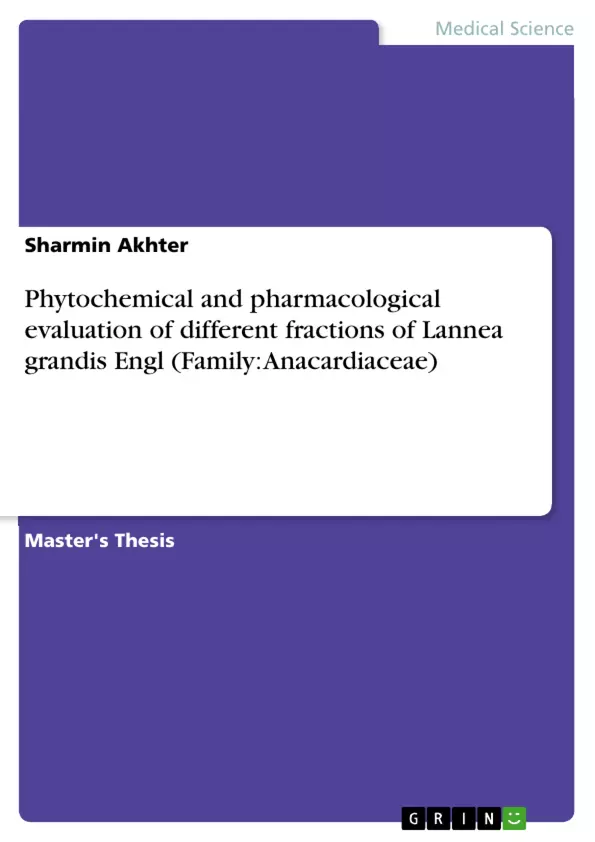The present research work was conducted to investigate the phytochemical and pharmacological activities of the different fractions of Lannea grandis Engl. (Family-Anacardiaceae). In phytochemical screenings with the crude extractives demonstrated the presence of alkaloids, steroids, tannins, saponins and gum. The antibacterial and antifungal activities of the crude extracts were evaluated by the disc diffusion method against 4 Gram positive and 7 Gram negative pathogenic bacteria and 7 fungi using Ciprofloxacin and Fluconazole as standards, respectively. In the screening, ethanol extract of L. grandis showed varying degrees of antibacterial activities than other two fractions with % zone of inhibition ranging from 46.09-48.42%, with strong activity against B. subtilis and S. aureus. On the other hand, the ethanol extract of plant also revealed mild to moderate antifungal activity with highest zone of inhibition of 20.5mm against B. dermatitidis. The MICs of the extracts were found to be 15.625-250μg/ml for both bacteria and fungal species used in the screening. During screening for antidiarrhoeal and antidepressant properties at dose 400mg/kg, significant (p<0.05) and dose dependent activities were observed in castor oil and Diazepam induced mice respectively. The plant extracts also revealed lack of analgesic activity performed on 0.7% acetic acid induced mice by using Diclofenac-Na as standard. The anti-inflammatory and the membrane stabilizing activities were assessed by using heat induced method and compared with acetyl salicylic acid as standard drug. The ethanol extract showed mild & significant (p<0.01) in-vitro membrane stabilizing activity compare to other fractions and ethanolic extract showed the highest anti-inflammatory activity in compare to the other two fractions of plant. In the screening of thrombolytic activity, the ethanol extract exhibited highest activity with % clot lysis 11.482 (p<0.01) compare to pet ether and chloroform fractions. Streptokinase used as standard which demonstrated % clot lysis of human blood 81.54 (p<0.001).So, the results obtained from this study indicate that these plant species could be useful in the search for new natural bioactive compounds.
Inhaltsverzeichnis (Table of Contents)
- Chapter-I: Introduction
- General introduction
- History of medicinal plants
- Significances of medicinal plants to human being
- Biological background
- Examples of plants used as medicine
- Risks to health
- Effectiveness
- Danger of extinction
- Innovation of medicinal properties of plants
- Existing status of medicinal plants
- Dependency of medicinal plants and traditional practicize in Bangladesh
- Medicinal plants in world context
- Medicinal plants in world market
- Drug development from medicinal plants
- Chapter-II: Literature review
- General description of Lannea grandis Engl.
- The plant family: Anacardiaceae
- The plant genus: Lannea
- Taxonomy
- Botanical features of the Lannea grandis
- Scientific classification
- Synonyms
- Common names
- Regions of distribution
- Countries of distribution
- Description of the plant
- Chemical constituents
- Common uses
- Distribution overview
- Tree size
- Literature review on plant family -Anacardiaceae
- Biological literature review on family Anacardiaceae
- Literature review on species Lannea grandis & related genus
- Chemical literature review on species Lannea grandis & related genus
- Biological literature review on species Lannea grandis & related genus
- General description of Lannea grandis Engl.
Zielsetzung und Themenschwerpunkte (Objectives and Key Themes)
This research aims to investigate the phytochemical and pharmacological activities of different fractions of Lannea grandis Engl. (Family: Anacardiaceae). The study focuses on identifying potential bioactive compounds within the plant and exploring their therapeutic potential. Key themes explored in the text include: * **Phytochemical analysis of Lannea grandis**: This includes identifying the presence of various bioactive compounds such as alkaloids, steroids, tannins, saponins, and gum. * **Pharmacological evaluation**: The study investigates the antibacterial, antifungal, antidiarrhoeal, antidepressant, analgesic, anti-inflammatory, membrane stabilizing, and thrombolytic properties of L. grandis extracts. * **Comparative analysis of different fractions**: The research compares the activity of different extracts of L. grandis, including ethanol, petroleum ether, and chloroform fractions. * **Potential for drug development**: The study explores the potential of L. grandis as a source of novel bioactive compounds for therapeutic purposes. * **Traditional medicinal uses**: The text also delves into the historical and traditional medicinal uses of Lannea grandis in Bangladesh and other parts of the world.Zusammenfassung der Kapitel (Chapter Summaries)
Chapter-I: Introduction
This chapter provides an overview of the significance of medicinal plants in human history and health. It discusses the historical use of medicinal plants, their relevance in the present day, and the potential risks associated with their use. The chapter also explores the ongoing research efforts to identify and develop new drugs from medicinal plants, emphasizing the importance of sustainable practices.Chapter-II: Literature review
This chapter delves into the botanical features of Lannea grandis Engl., including its taxonomy, scientific classification, synonyms, common names, regions and countries of distribution, and chemical constituents. It also presents a comprehensive literature review on the family Anacardiaceae, focusing on both chemical and biological aspects, and specifically examines existing research on the species Lannea grandis and related genera.Schlüsselwörter (Keywords)
This study focuses on the phytochemical and pharmacological evaluation of Lannea grandis Engl., a medicinal plant belonging to the family Anacardiaceae. The main keywords include: Lannea grandis, Anacardiaceae, phytochemical analysis, antibacterial activity, antifungal activity, antidiarrhoeal activity, antidepressant activity, analgesic activity, anti-inflammatory activity, membrane stabilizing activity, thrombolytic activity, bioactive compounds, medicinal plant research, drug development.- Quote paper
- Sharmin Akhter (Author), 2012, Phytochemical and pharmacological evaluation of different fractions of Lannea grandis Engl (Family: Anacardiaceae), Munich, GRIN Verlag, https://www.hausarbeiten.de/document/276334


